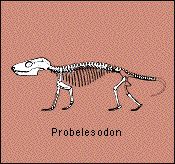Macroevolution

Macroevolution is evolution on the grand scale: the term refers to events above the species level; the origin of a new higher group, such as the mammals, would be an example of a macroevolutionary event.
Macroevolution has mainly been studied morphologically, because we have more taxonomic and fossil evidence than for other kinds of characters, such as physiology or chromosomes.
According to the neo-Darwinian theory of macroevolution, major evolutionary transitions such as the origin of mammals from reptiles - well documented in the fossil record - occur in gradual adaptive stages. However, macroevolution may proceed by developmental macromutations as well as by gradual adaptation.
Macroevolution can be contrasted with microevolution: evolutionary changes on the small scale, such as changes in gene frequencies within a population. A major issue relating to many controversies in evolutionary biology is the extent to which macroevolutionary changes can be explained by microevolutionary processes.
The illustration opposite is of Plobelesodon: an intermediate between reptiles and mammals. Its history is studied as a macroevolutionary event.
| Next |



